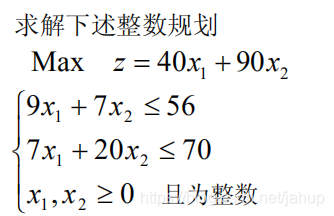Branch and bound method:
Introduction: Properly systematically search for all feasible solution spaces of the optimization problem with constraints (the feasible solution is a finite number). This is the content of branching and delimiting.
Example:

Solution: Without considering x 1, x 2 x_1, x_2x1,x2In the case of an integer, the following results are obtained.

Then it can be seen that when x 1, x 2 x_1, x_2x1,x2When it is an integer, the value of z cannot be greater than the above result, then z at this time can be used as the upper bound, obviously when x 1, x 2 x_1, x_2x1,x2When it is 0, z=0, then 0 can be used as the lower bound. Because x 1 x_1x1=4.9092, then we respectively assume x 1 x_1x1=4 or x 1 x_1x1=5
get the following result


Then the limit can be changed to 0 ≤ z ≤ 349 0\leq z \leq 3490≤with≤3 4 9
Then we arepairing x 2 x_2x2=2.1 branch is x 2 x_2x2= 2 or x 2 x_2x2=3, available separately

Then cut out x 2 x_2x2=3 (327.14<340)
at this time the limit can be changed to 340 ≤ z <349 340\leq z <349340≤with<3 4 9 (In the case of 340,x 1, x 2 x_1, x_2x1,x2Are integers, you can reduce the lower bound)
and then set x 2 x_2x2=1.57 branch to x 2 x_2x2=1 or x 2 x_2x2= 2 (no solution)

because 308 <340 308 <340308<3 4 0 cut off, now only left

In one case (all the others have been subtracted), this is the optimal solution

--a scientific super-electromagnetic gun